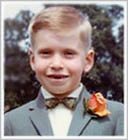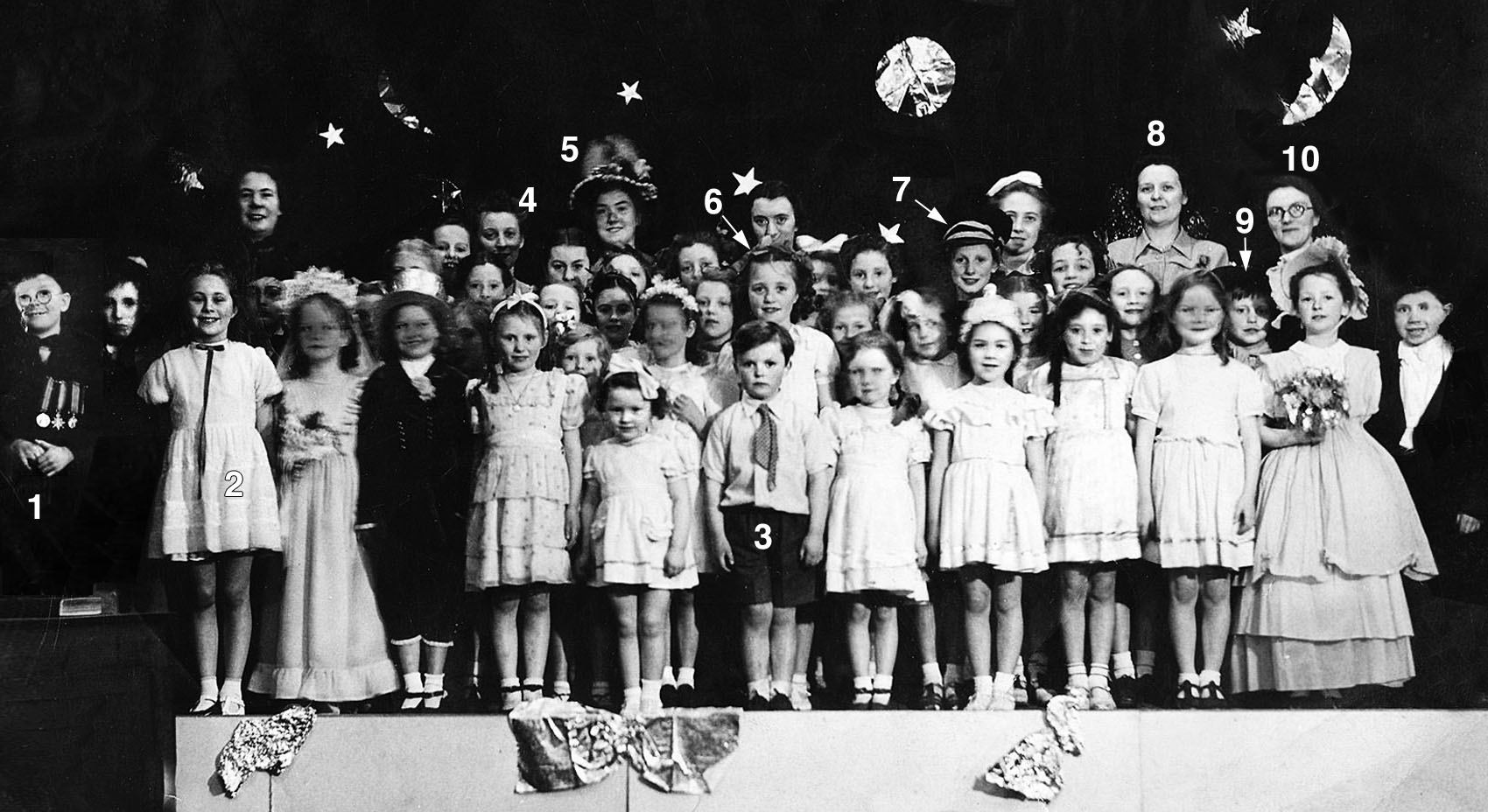An Illustrated History of Old Sutton in St Helens, Lancashire
Part 8 (of 95 parts) - History of Religion in Sutton Part 1 (C. of E.)
Also see: Part 2 (St. Anne’s) | Part 3 (St. Theresa & St. Joseph) | Part 4 (Chapels)
Photo Album | Researched & Written by Stephen Wainwright ©MMXX Contact Me
Part 2 (St. Anne’s) | Part 3 | Part 4 | Photo Album
Researched & Written by Stephen Wainwright ©MMXX
Old Sutton in St Helens
a) Religion in Sutton Introduction
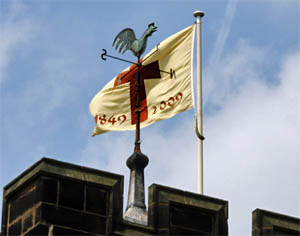
With no place of worship in Sutton, the township's denizens either had to journey to St.Mary's or walk or ride through miry lanes to St.Helen's church in Hardshaw (then spelt Hartshaw). From 1388, the fit and able Suttoners could choose to attend Farnworth church near Widnes, which was built by Sir John Bold, and from the 1830s worshippers could also commute to Parr to attend services at the original church of St.Peter's.
For those passing through Sutton, roadside crosses were strategically placed on Marshalls Cross Road and Peasley Cross Road, so that travellers on those highways could stop and pray for a safe journey. This important north-south route probably dates back even earlier than Roman times. The more well-to-do Sutton residents might worship at home or at their friends' or neighbours' houses with services ministered by travelling preachers.
However, large numbers of the township's working class were either unable or unwilling to attend church. It was said by Methodist preachers in 1800 that many of Sutton's colliers had never heard the word of God until they addressed the miners at open air meetings. Sometimes ministers would preach to labourers at their own works and during the nineteenth century, the Congregational Church regularly held bible classes in a room at the Sutton Copper works.
As the Sutton population expanded during the nineteenth century, churches within the township were seen as necessities. The first purpose-built place of worship was built in Lancots Lane in 1845 by the Wesleyan Methodists. However, the Sutton Parish Church of St.Nicholas was hot on its heels and was built in New Street on a much bigger scale.
b) Sutton C. of E. Parish Churches
To commemorate the fourth centenary of the founding of King's College, Cambridge by Henry VI in 1441, their Provost and Fellows elected to build a church at Sutton and endow it as a vicarage separate from Prescot. On October 18th 1841 the College agreed to pay £500 towards the cost of construction and then a further £2000 was raised by subscriptions from individual College members. The most generous private benefactor was Rev. Harry Dupuis, who became Vicar of Richmond, a parish that the second Sutton vicar would eventually serve.It took some time to fInd a suitable site for the new church but in 1846 an acre of land in New Street, near the old Sutton workhouse, was chosen as its location, with the ground donated by Sir Henry Bold Houghton. The church was dedicated to St. Nicholas, a patron saint of King's College Cambridge and was built from pink sandstone. The renowned Lancaster architects Edmund Sharpe and Edward Paley were commissioned to design the building, which was well in advance of the general style of ecclesiastical buildings prevalent at that time. Credit should also go to Christopher Barnes and Robert Wilson who were in charge of the stonemasonry and carpentry respectively.
The Hughes family of Sherdley Hall also contributed to the funding of Sutton Church, as it was usually known, with its consecration held on June 4th 1849 by the Bishop of Chester, the Rev. John Graham. The total cost of the building and expenses was over £3900, which was more than had been budgeted and so King's College increased its contribution to £1270. However there was still insufficient cash for a church tower and a vicarage, which would have to wait until more funds could be found at some point in the future.
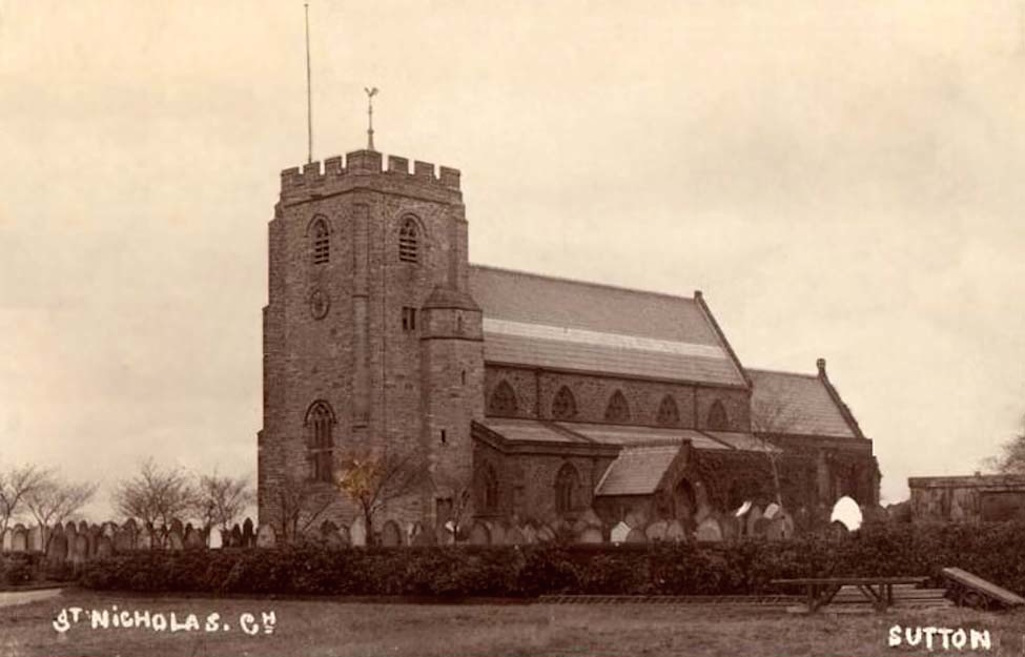
A postcard photograph of St.Nicholas Church in New Street, Sutton which was taken around 1905

A postcard photograph of St.Nicholas Church which was taken around 1905

A postcard photograph of St.Nicholas
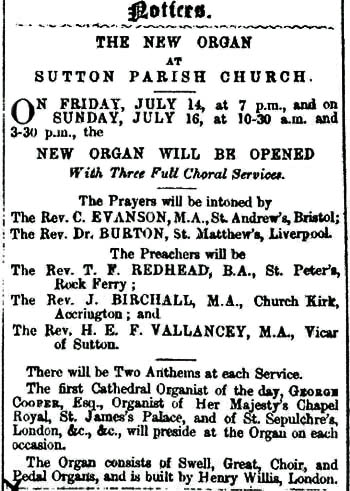
On July 14th and 16th 1865, a new organ was unveiled at the church which was made by Henry Willis of London and donated by Lord of the Manor, William Roby Pilkington. Rev. Vallancey invited Cathedral organist George Cooper of St. James Palace's Chapel Royal in London to perform in three choral services that were held over the two days. Four prayer-readers and preachers were also brought in for the celebratory occasion. Incidentally the Willis organ is still in regular use in the New Street church.
On November 21st 1871 the Liverpool Mercury reported how going to Sutton Church had become an invitation for burglars. In describing how Edward Rigby of Robins Lane had had his house burgled on the previous Sunday evening, the newspaper claimed that St.Helens was 'infested with burglars from Liverpool every Sunday evening, who watch families to church and then plunder their houses.' In 1879 an east window was added to the church which was designed by expert stained glass window designer Henry Holiday.
Little seems known of early curates at St. Nicholas Church apart from William Smith who was a curate until 1874 and Gibson Downing, who arrived in January 1884. Two years later Downing was appointed curate-in-charge with full control of the parish as a consequence of Rev. Vallancey's infirmity, until the latter's death on September 19th 1888 and the arrival of his successor.
On January 5th 1889 the St Helens Reporter described how Rev. Downing had presided over the annual Sunday School prize-giving at Sutton National School, in which prizes were awarded to children with a good attendance record and for ‘meritorious conduct’. The proceedings featured entertainment from the children, including a musical drill, songs, recitations and glees. Gibson Downing also presided over the fortnightly meeting of the Sutton Parish branch of the C. of E. Temperance Society, in which various individuals sang songs and hymns and gave readings.
Downing transferred to St. Columba's church in Liverpool, making way for Maximilian Frederick Breffit Binney. The St.Helens Reporter also wrote on January 5th 1889 that Rev. Binney as vicar-elect had sent parochial magazines containing a New Year’s address for distribution to Sutton parishioners, which had created a very favourable impression. He had been the Vice-President of Cambridge Clergy Training School and took his inaugural service at St. Nicholas on February 3rd 1889.
One of Rev. Binney's first acts was to accept a piece of land worth £400 from Michael Hughes of Sherdley Hall. As the population of Sutton was expanding, so were the numbers who were dying and the plot was needed to enlarge the Sutton Parish Churchyard. Every year the 50 or so members of St. Nicholas Church choir and Sutton National School choir enjoyed an outing to a seaside resort. In August 1889 a local venue was chosen instead and the party journeyed in three horse-driven wagonettes to the Bold Hall Park, where a tent had been especially erected for them. A rare tour of the hall was one of the attractions enjoyed by the group, which was led by Rev. Binney.
St. Nicholas only provided seating for 358 persons and since its construction a large number of new works had opened within the St. Helens Junction district, with many houses built nearby to accommodate workers. The population of the parish in 1861 had been 4071 but within thirty years it had doubled to 8505. At the evening harvest festival service on October 13th 1889, the church was so crowded that many people were unable to gain admission into the church. It was also a bit of a trek from the Junction to St.Nicholas at the end of New Street, especially for young children.
So the decision was taken to build a second church in Ellamsbridge Road, adjacent to the National Schools and dedicated to ‘All Saints’. The question of building a second C. of. E. church in Sutton was first considered in 1889 and a building committee was formed to choose a site and prepare a suitable scheme. A meeting of parishioners took place on April 28th 1890, which passed a resolution in support of the scheme ‘in view of the inadequacy of the existing church accommodation and growth of the population.’
The new place of worship cost £6,800 and the major benefactors who funded the enterprise included William 'Roby' Pilkington, who provided the site plus £1000, and Sutton Glass Works managed by William Blinkhorn who donated £500 of his own money and also passed on £300 from shareholders. Blinkhorn’s daughter Emily, incidentally, married Rev. Binney in 1898. Harriet Whyatt of Bold Hall contributed £600 and £100 each was contributed by Edith Hughes of Sherdley Hall, Arthur Sinclair, Mr. F. Pemberton and King's College, Cambridge. There were various fundraising events to make up the balance of the cost of construction, including a polo match held at Grange Park on July 13th 1891 between members of the Liverpool Polo Club.
All Saints was built from red sandstone by Bootle builder S. Webster and like St. Nicholas, was designed by the renowned architects Paley, Austin & Paley, as the Lancaster firm was now known. On August 4th 1891 William Pilkington's daughter laid the foundation stone for the church, deputising for her mother who wasn’t well enough to attend. The occasion was marked by a procession of schoolchildren from the nearby schools and speeches by Arthur Sinclair, William Pilkington and Rev. Binney.
A collection amongst those gathered elicited the considerable sum of £75 for the new church, which was initially planned to accommodate 600 worshippers. It was designed to be 128 feet in length, with its greatest width being exactly half that figure. A central tower would be a notable external feature of the new church but it was decided to delay its erection until additional funds could be raised.
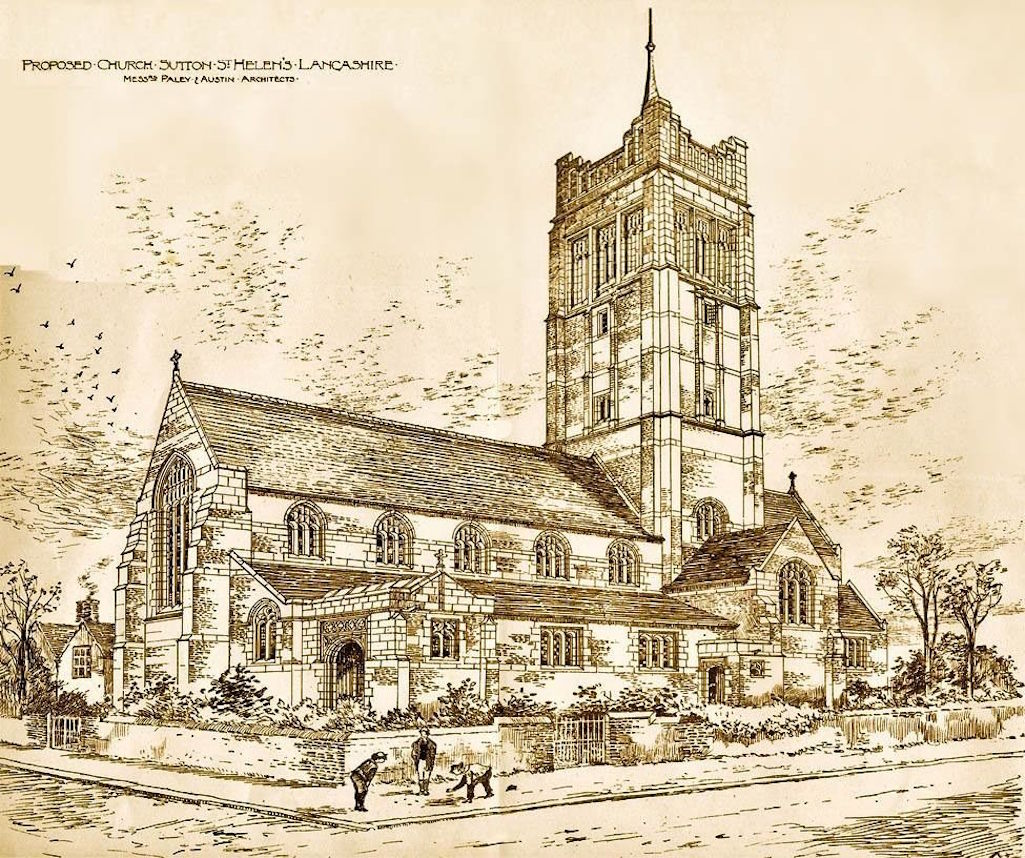
Architects Paley & Austin's original plan of All Saints Church which was published in The Building News of 10/7/1891

Paley & Austin's plan of All Saints Church published in The Building News

Paley & Austin's plan of All Saints
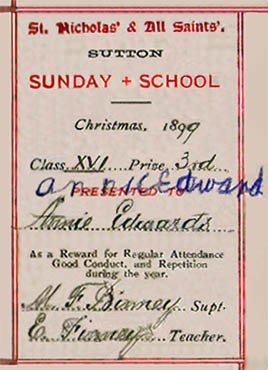
This was now the second Church of England place of worship in Sutton parish and for many years a solitary vicar held services at both churches, supported by curates. Although often referred to as 'St.Nick's' church today, for much of the twentieth century, St.Nicholas was known to Suttoners as 'Top Church', to differentiate it from All Saints within the more residential Sutton Village. However within ecclesiastical circles the New Street church was known as the parish church and the place of worship in Ellamsbridge Road was known as the district church.
Improvements were made to St. Nicholas whenever funds allowed. A Liverpool Mercury article from January 26th 1897 stated that Parr contractor Peter Tickle had commenced work on a tower for St.Nicholas. This was set to cost between £700 and £800 and was added to commemorate the diamond jubilee of Queen Victoria’s reign. The funds had been provided by Charlotte Hughes of Sherdley Hall, who'd donated £1000 in memory of her mother Ellinor, who'd died in 1895, with the balance going towards the reseating of the body of the church. However the aunt of Captain Michael Hughes died on October 16th 1897 without apparently seeing any of the improvements.
A condition was that the two front sets of pews be reserved ‘forever’ for the use of Sherdley Hall. Two plaques were attached to the pews to inform worshippers of this, which still exist today. A few Suttoners can still recall as children, seeing the tall, powerfully-built Michael Hughes III in his reserved seating at the front of the church singing hymns. With Hughes's death in 1938 and the sale of the contents of Sherdley Hall in the following year, the plaque's in perpetuity condition only lasted forty years.
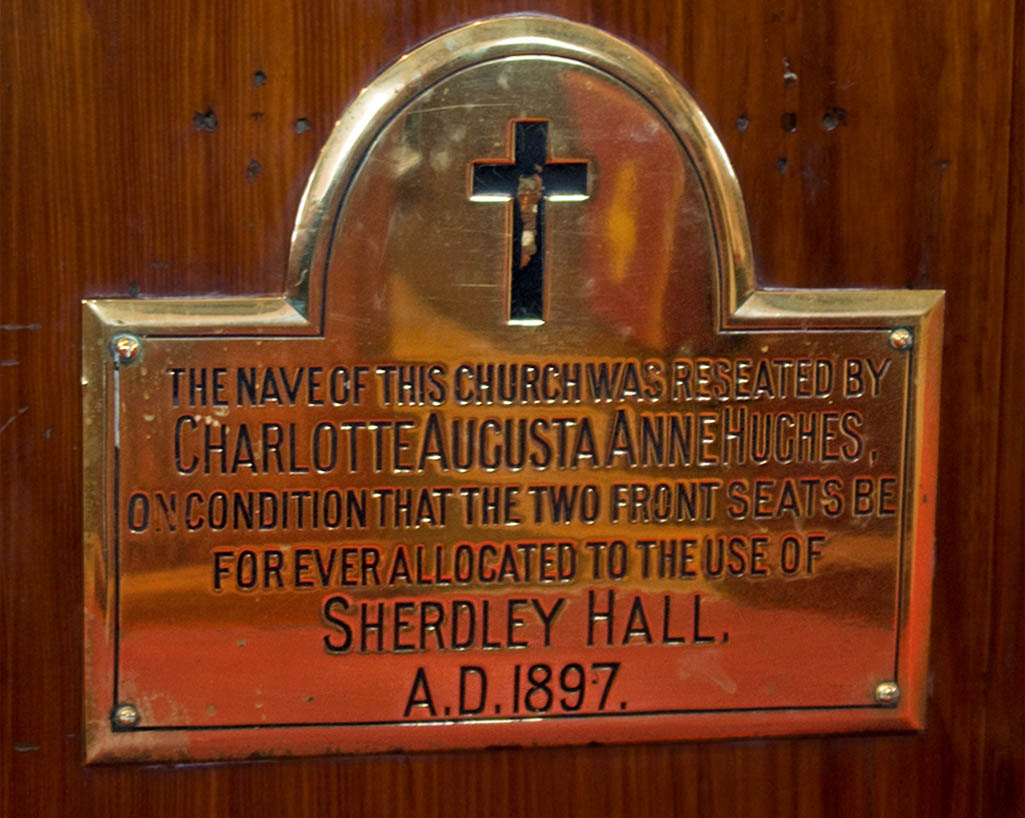
The Hughes plaque on the side of a pew in St.Nicholas church reserving seats for Sherdley Hall - photographed in 2011

Hughes plaque on a pew in St.Nicholas reserving seats for Sherdley Hall

Hughes plaque on a St.Nicholas pew
On June 9th 1898 the Manchester Guardian reported how Rev. Binney had been contemplating resignation for some time through the heavy strain of looking after the parish. However he had now decided to remain in Sutton, on condition that he was allowed six months leave of absence. This was spent touring through Greece and it also served as the vicar’s honeymoon as in October 1898, Binney married Emily Blinkhorn in Kendal, the daughter of William Blinkhorn of Sutton Grange.
Of the curates who served the parish during this period, a mention should be made of Rev. Frederic W. E. Chadwick. He was curate at All Saints and St. Nicholas churches for four years from 1894, and was given much credit for improving the Sunday Schools. While under his charge these had grown to an average attendance of 652 children, after he had vigorously pursued absentee pupils in their homes.
The number of prizes awarded to successful students also increased and in 1898 the figure stood at 247. In appreciation of his efforts, Rev. Chadwick was presented with 25 books and the large sum of £40, just before he left the parish for Blackburn in March 1898. One minor blemish occurred on August 20th 1897 when Chadwick was fined five shillings in St.Helens Police Court for allowing his dog to be at large unmuzzled.
Another curate was Rev. R. L. Wing who in December 1894, after leaving Sutton for a curacy in Derbyshire, was sued by a moneylender in St.Helens County Court for £22. There was also the Rev. Granville Bourdas Thurston who was a champion runner when at Cambridge and left Sutton to become Rector of Lymm. Also around this time Rev. R. H. Reilly served as curate-in-charge for several months. Then there was Rev. Reginald Lane Wolkenberg who was another All Saints curate who found himself in the newspapers. However this was as a result of a burglary at his Sutton home during April 1905. He had been born in Rumania to a Russian father, who became a naturalised British subject and had married a woman from Kent.
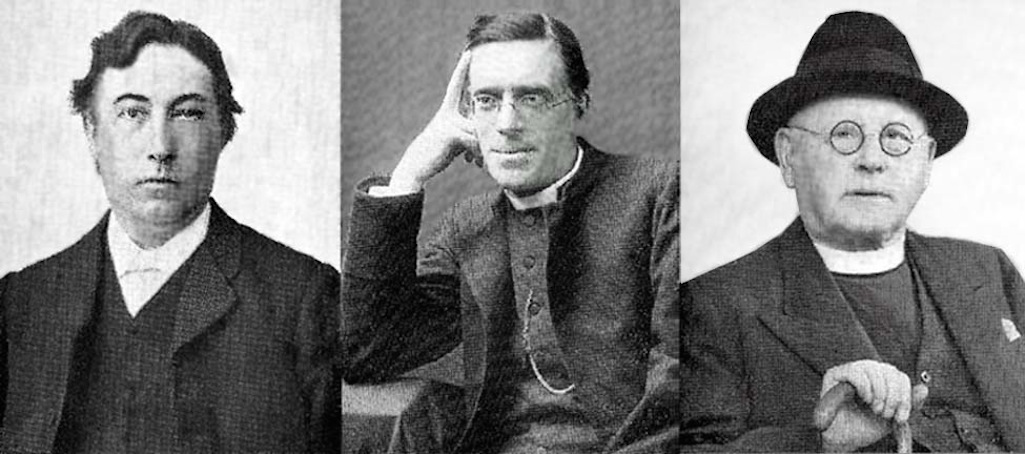
Revs. M.F.B. Binney (1889 - 1900), F.S.C. Crane (1901 - 10) & W.E. Colegrove (1910 - 39) - Contributed by James Prescott

Sutton vicars Revs. M.F.B. Binney, F.S.C. Crane and W.E. Colegrove

Revs. Binney, Crane & Colegrove
By the turn of the new century, the influence and authority of vicars within their communities was diminishing. The days when the likes of the Rev. Henry E. F. Vallancey could write stern letters to the wealthy demanding money for his National Schools project - as he did in 1856 to Ellen Hughes - were becoming numbered. Automatic respect from parishioners was also on the wane and the next two Sutton vicars generated much controversy.
Rev. Binney was replaced in Sutton by Frederick Sydney Cooper Crane, who was born in South America about 1863 and had been the Rector of Lower Crumpsall in Manchester. There seemed to have been some difficulty in Crane taking up his appointment straight away, as advertisements appeared in newspapers requesting a priest's temporary help. Applicants had to be 'moderate', 'single' and a 'good preacher' with £160 offered for work of 'some months' within Sutton Parish. R. H. Reilly seems to have become the curate-in-charge during this period.
Also in 1900 William ‘Roby’ Pilkington continued his largesse to the parish with a donation of £1000 towards the building of a vicarage in New Street. The church benefactor, now resident in Roby Hall, also persuaded King’s College Cambridge to contribute a further £1000. The patrons of the living had always intended to build a home for the Vicar of Sutton and in the late 1840s had acquired a piece of land adjacent to the new church expressly for that purpose. However the building of St. Nicholas cost more than was expected and so the vicarage was put on the backburner, with priests residing in houses within Green End and Mill Lane.
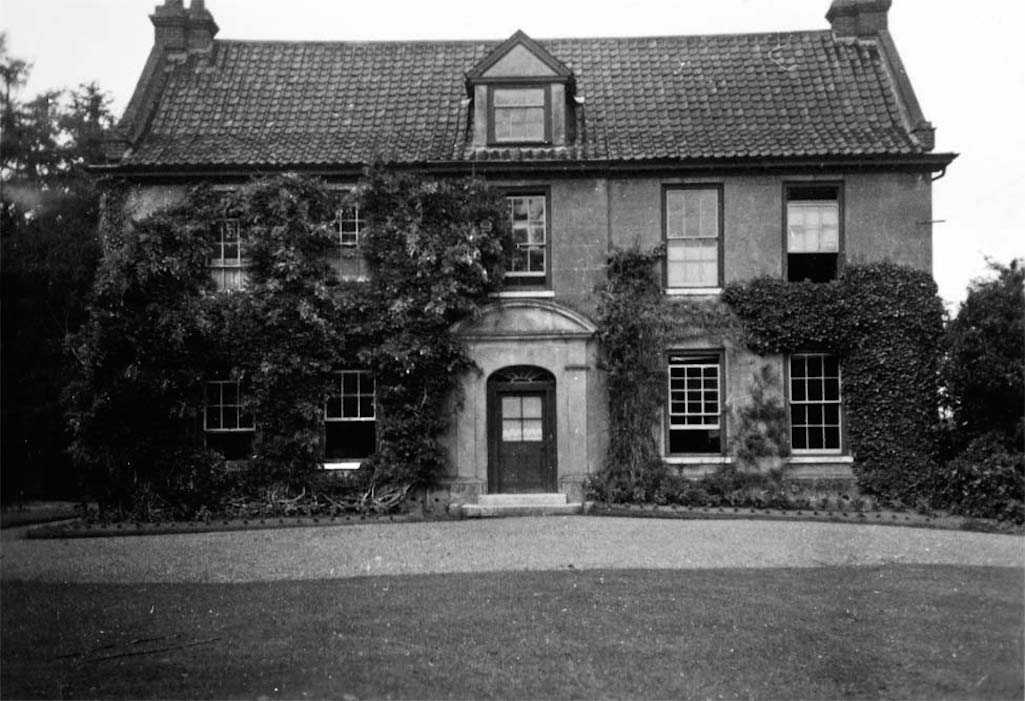
Sutton Vicarage in New Street pictured during the 1960s - Contributed by Patrick Smith

Sutton Vicarage in New Street in Sutton pictured during the 1960s

Sutton Vicarage during the 1960s
The St Helens Newspaper described it as a ‘commodious modern building’ surrounded by spacious gardens, with a tiled roof, ten bedrooms, plus large drawing and dining rooms. There was also a very large combined study and parish room measuring 30 feet by 14 feet, which the newspaper described as a ‘novelty in vicarages’. This was to to be used mainly for meetings and other parochial activities. Within a few months Rev. Crane was able to move in with his Irish wife Florence and toddler daughter Barbara. The vicarage existed for many years and the site is now occupied by a care home.
On April 25th 1902 the St.Helens Newspaper wrote that St.Nicholas church ‘needs to be made safe, draught-proof, and warm; and it sorely needs the beautifier’s hand’. Over the previous five decades the church had suffered through subsidence and the weather and so now needed some restoration work. A ‘bazaar’ held in St.Helens Town Hall raised some funds for this, although the primary purpose of the event was to pay for the erection of Marshalls Cross School.
Rev. Crane said at the opening ceremony that the bazaar had been the product of ten months preparation in Sutton, with the whole parish being “one hive of industry”, creating “wonderful works of art”. The assembly hall featured many stalls and was decorated so it resembled a street in the fictional town of Pynka Pong in ‘San Toy’, the hugely popular ‘Chinese’ musical comedy that had recently been performed in London.
Rev. Crane only had a brief honeymoon with his parishioners, who were soon holding protest meetings to allege ritualistic practices at his St. Nicholas church. The Sutton vicar had reconstructed the chancel by the altar, fitting a new floor, Communion table, rails and fittings. The latter was said to have been beautiful and included a brass cross that had been presented to the church by Henry H. Campbell, the Sherdley Estate Manager. On Sunday evening May 24th 1903, when the vicar moved to the communion table to dedicate the new cross and ornaments, a large body of the 300 members of the congregation walked out of the church in a disorderly manner. Reuben Fowles, described as people's warden, wrote to the Bishop of Liverpool alleging this was ritualism.
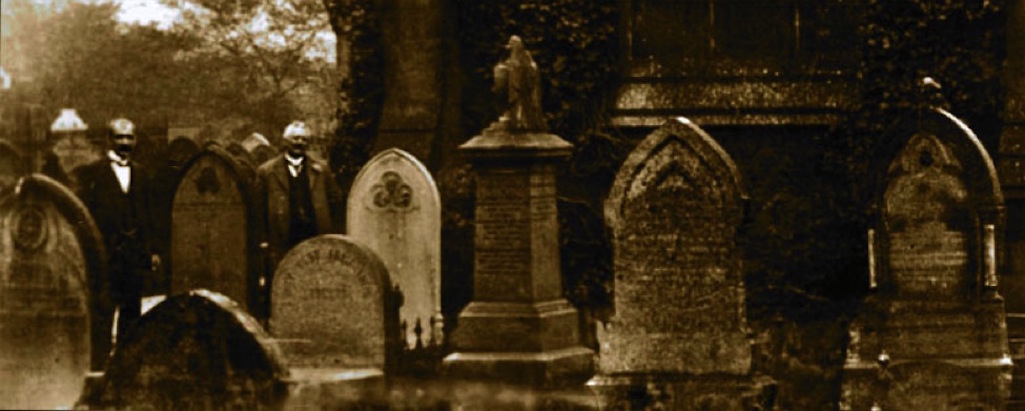
A picture of Sutton Parish churchyard at the front of St.Nicholas Church taken around 1910

A picture of Sutton Parish churchyard at the front of St.Nicholas Church c.1910

Sutton Parish churchyard c.1910
However Dr. Henry Baker Bates proposed an amendment that a faculty be instead applied for to remove the cross and ornaments. (Bates, incidentally, replaced Henry Campbell as Sherdley manager in 1906.) This was carried by a very large majority with the meeting punctuated with cries of 'Down with Popery' and 'Down with Ritualism'. The Bishop of Liverpool felt that the feelings of the meeting should be honoured and the vicar somewhat grudgingly complied.
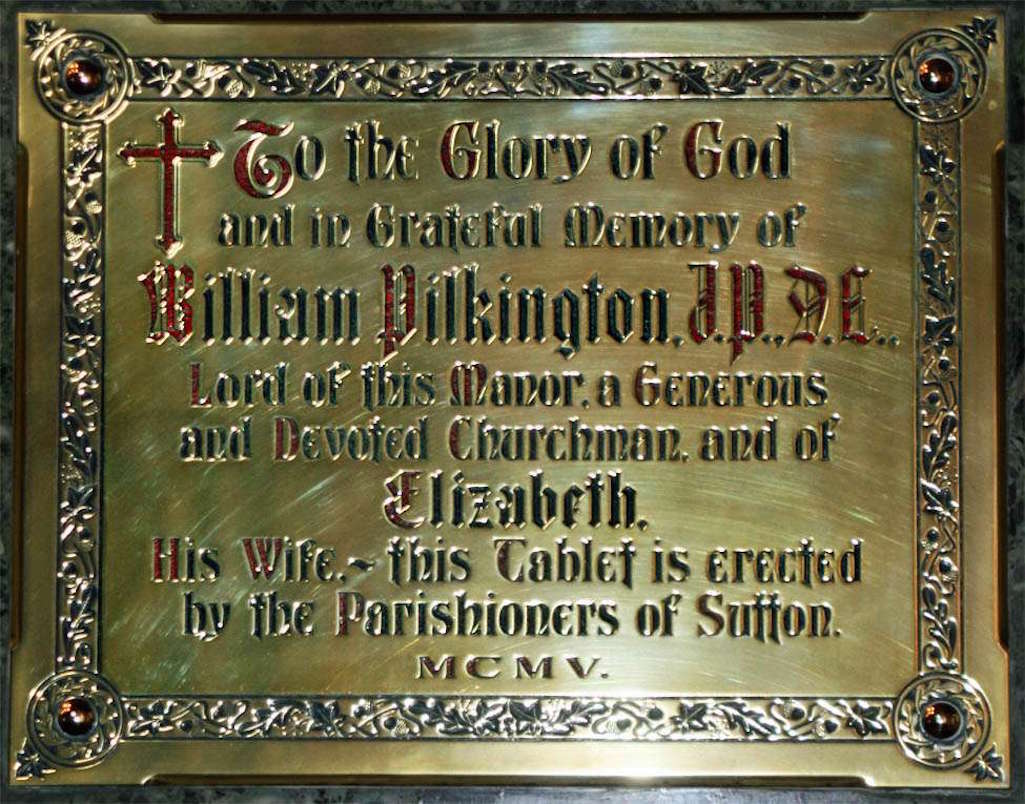
Brass tablet inside St. Nicholas church that serves as a memorial to the late William Pilkington and his wife

Brass tablet inside St. Nicholas that serves as a memorial to William Pilkington

Brass tablet inside St. Nicholas church
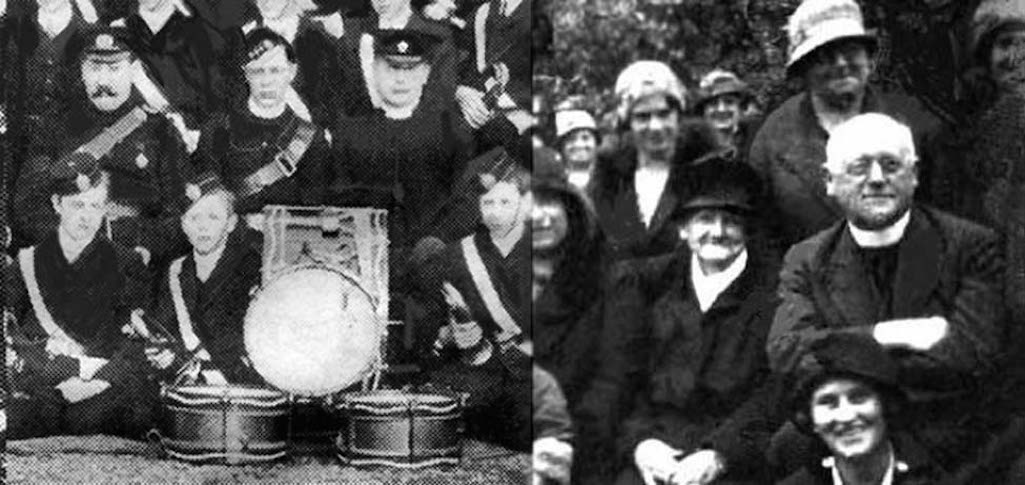
Two pictures of Rev. Colegrove: a) to the right of the drum in 1911 with the Church Lads Brigade; b) On an outing c.1935

Two pictures of Rev. Colegrove - Left: to the right of the drum in 1911 with the Sutton Church Lads Brigade; Right: On a church outing about 1935

Left: Rev. Colegrove in 1911 with the Church Lads Brigade; Right: c.1935
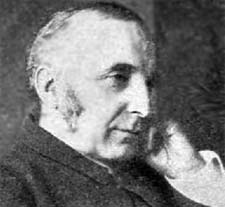
On April 28th 1911, Sherdley Estate agent Henry Baker Bates wrote to his boss Michael Hughes that "Mr. & Mrs. Colegrove are receiving the whole hearted support of the Sutton people and everything points to a successful result." One of the new vicar's first acts was to apply in July 1911 to the Liverpool Consistory Court to replace the gas lighting in All Saints with electric light. The retrospective application was also made in the name of the Ellamsbridge Road church's wardens, Thomas Manifold Winstanley and a S. Foulkes. Mention should also be made of Reverend T. Holme who was a curate in Sutton Parish at this time.
Further improvements were required for both of the Sutton churches, so another bazaar was held in St.Helens Town Hall’s Assembly Room to raise the necessary funds. The three day event began on October 19th 1911 and was styled as the Coronation Bazaar, as George V’s coronation had taken place four months earlier. There had been a full year’s preparation for the bazaar, which according to the St.Helens Newspaper, displayed a ‘magnificent collection’ of ‘beautiful articles’ on the many stalls. These included a Vicarage stall run by Mrs. Jessie Colegrove, Mill Lodge stall, Sutton Manor stall and a number of Sherdley stalls. The latter were run by Edith Hughes, who had Viscountess Wolmer and Mary Lady Gerard assisting her.
The first day was opened by Lord Derby with many notable persons in attendance. Well over £1000 was raised, which went towards a number of improvements at St. Nicholas. These included the building of a new organ chamber on the site of the present vestry, new choir and clergy vestries, the reseating of part of the church and the provision of choir stalls in the chancel. At All Saints’ church the funds paid for a fence that was installed round the building, plus other minor enhancements.
On February 23rd 1913, the Bishop of Liverpool, Francis Chavasse, delivered addresses at two church services in Sutton. In the morning he preached at St. Nicholas to commemorate an extensive renovation. The walls of the church had just been redecorated, the flooring renewed and oak choir stalls had been fitted. The latter was the gift of Colonel Lee Pilkington, who had inherited the title of Lord of the Manor of Sutton from his father William. The Men's Bible Class at St. Nicholas had also raised funds for a new baptismal ewer. In the afternoon the Bishop dedicated a new entrance porch at All Saints church.
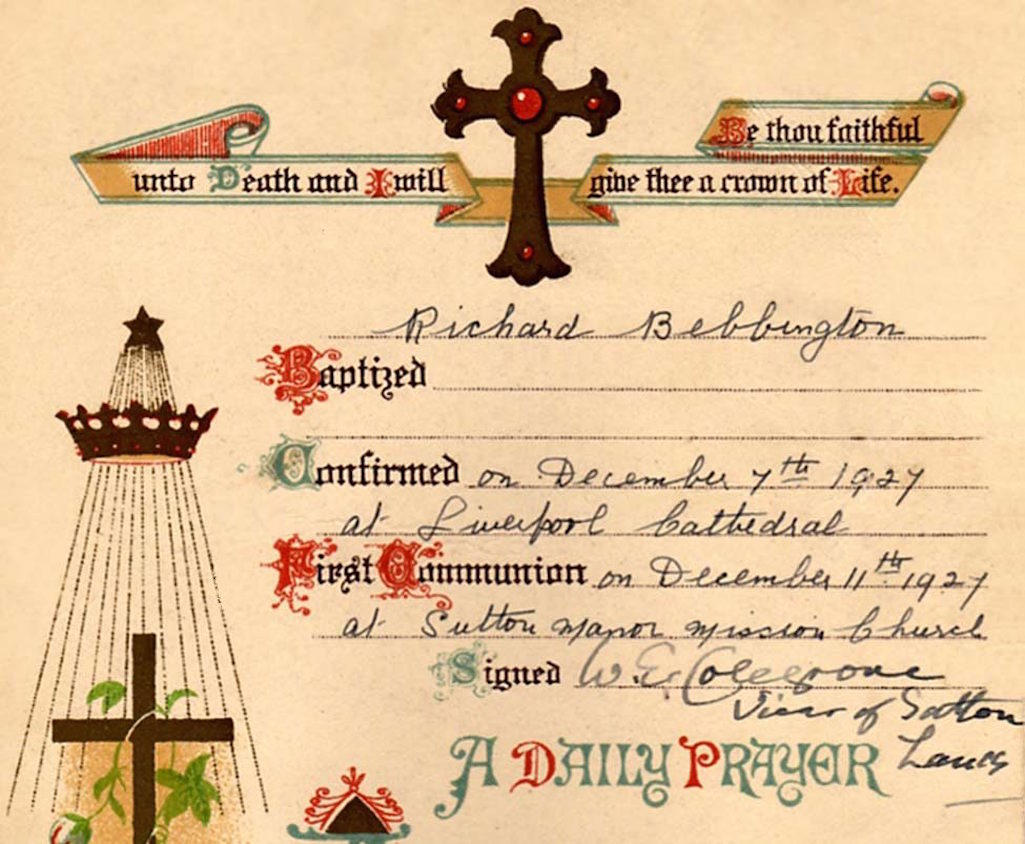
Part of Richard Bebbington's church record card as an attendee of Sutton Manor Mission - Contributed by Mel Moran

Richard Bebbington's church record card as attendee of Sutton Manor Mission

Richard Bebbington's church record card
Rev. Joseph Hignett Bankes was licensed by the Bishop of Liverpool to serve at curate in Sutton Parish on December 17th 1917. On March 4th 1918 he found himself in court for not having a red rear light on his bicycle. Rev. Bankes was admonished by the Bench for his attitude after he'd been stopped by Special Police Constable Harrison. The curate had told the officer that he'd had his lamp stolen a week earlier but could "not be bothered running down to St. Helens to buy lamps". The Mayor Alderman Henry Bates fined him £2 and 10s. costs and said it was a serious thing for a gentleman in his position to "set the law at defiance".
The St.Helens Reporter of April 19th 1918 reprinted the Vicar of Sutton's comments in his parish magazine on the funerals of those that had died from infectious diseases. The Rev. William Colegrove wrote that the bodies of those who had died from such diseases had for some time not been allowed to enter St Nicholas church. Instead the coffins were taken from the entrance of the churchyard directly to the grave. This he said was to prevent the spread of disease from an infectious body. A week later the Reporter published further comments from Rev. Colegrove in which he called for mourners to carry coffins:
At the Sutton Parish Church Council’s meeting in March 1919 it was decided that the Sunday schools, choirs, Waterdale Mothers Meeting and other institutions should have their field days and outings held as in pre-war times. During the war many of these had been suspended for the duration. The vicar pointed out that June 11th would the 70th anniversary of the consecration of St. Nicholas Church and it was decided that a suitable commemoration would be to furnish the west end of the church with seats. These would fill a space previously occupied by the choir and organ.
On July 25th 1919 the Vicar of Sutton appeared in St.Helens Police Court for riding a cycle without a rear light. Although Rev. Colegrove pleaded guilty, he gave a long-winded cross-examination of a police officer, much to the irritation of the Bench and the Chief Constable. A century ago electric lamps on the front and rear of vehicles were still in their experimental phase and the vast majority of owners used acetylene gas lamps. These had to be lit and sometimes went out during a journey. Colegrove was fined 5 shillings.
On December 10th 1919 a memorial service was held at All Saints for Lee Pilkington, which was attended by many dignitaries - including the Mayor of St.Helens. Colonel Pilkington had been born at Sutton Grange in Marshalls Cross Road and he and his wife Sybil had been benefactors to Sutton Parish for many years. Lee had in fact inherited the title of Lord of the Manor of Sutton from his father William Pilkington.
In the middle of March 1920 a meeting of parishioners was held in which it was decided that war memorials should be installed in the two churches to commemorate those that had lost their lives in the war. At St Nicholas the names of the fallen would be listed on an oak mural tablet and in All Saints a carved oak pulpit would serve as a memorial. A parochial hall would also be built. A committee was established to carry out the scheme and a public appeal for donations was launched.
Also in 1920, a Church of England Mission was created in the mining village of Sutton Manor. Its original location was the Clock Face Colliery School in Lindsay Street (later renamed St. Aidan’s) and the first services were held on Easter Sunday. There were three services held with Canon Baines, the Vicar of St Helens, preaching in the afternoon. Collections were made for an equipment fund, for which £150 was required, including £30 for an organ. When the Sutton Manor Miners' Institute opened in 1922 in Jubits Lane, the mission took over a large room. During the week the room was used for dancing or brass band practice but on Sundays it became a church. This was not without some controversy due to alcohol being sold in the club, however on the Sabbath all such sales ceased.
John Houghton of Forest Road was choirmaster during the 1930s and the Sutton Manor C. E. Mission Sunday school held their annual New Year party in the Sutton Manor Colliery Institute. A report in the St. Helens Reporter on the 1939 event said: ‘After tea, served by Mesdames Walsh, Phythian and McMiken, the children themselves gave an impromptu entertainment for one another, giving songs, dances and sketches’. In July of each year the Sutton Manor Mission Fete – involving a procession and field day in Bell Lane - was held. Another C. of E. mission was created in Clock Face and they were both replaced by St. Michael & All Angels in Gartons Lane, which cost £11,000 to build (plus furnishings) and was dedicated by the Bishop of Liverpool, Clifford Martin, on September 15th 1953.
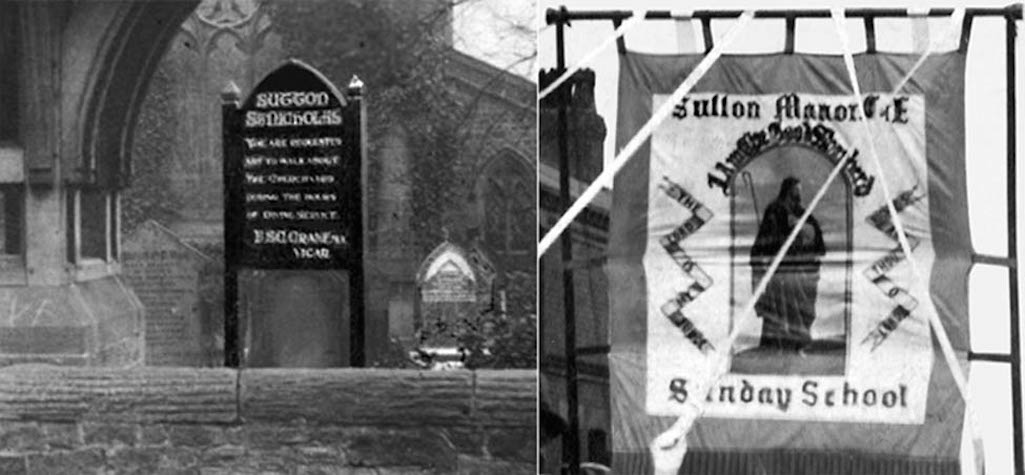
St.Nicholas Church c.1905 when Rev. Crane was vicar and Sutton Manor Mission Sunday School banner

St.Nicholas Church c.1905 and Sutton Manor Mission Sunday School banner

St.Nicholas c.1905 and Sutton Manor Mission Sunday School banner
The latter only lasted a matter of weeks and was replaced in June by the Rev. John Yorke Lodge. However the Sutton housing crisis was so severe that he had for some time to commute into Sutton. The Lord of the Manor, Col. Lee Pilkington, had just before his death donated a house for use by the Sutton curacy but there was a lengthy delay in obtaining vacant possession.
On May 5th 1920 All Saints Church held their first open-air service in Fisher Street. The St Helens Reporter of August 13th of that year stated that St Nicholas Church choir had spent a "happy day" in Southport on their annual outing. The All Saints choir was visiting Chester on the following day and the Mothers Meeting' excursion was also going to be to Southport. Another story in the newspaper was that a committee was organising a series of house visits to raise funds for war memorials for St. Nicholas and All Saints’ churches.
In the following week the Reporter stated that there had been a marked improvement in the churchyard at St. Nicholas after it had become "very much overgrown with rank grass". They added that "It is a pretty churchyard and might be made very beautiful but all that, no doubt, is a matter of money, which is the trouble."
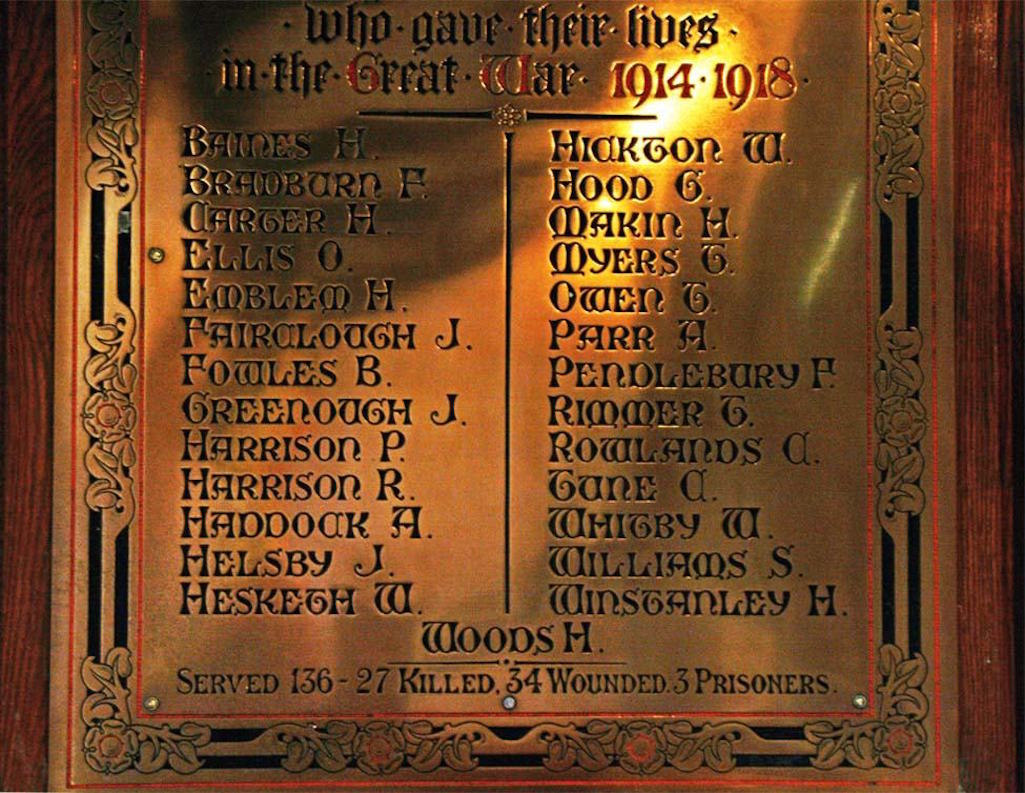
Great War memorial to members of the Sutton Parish Young Men's Bible Class in St. Nicholas church

Great War memorial to members of Sutton Parish Young Men's Bible Class

Great War memorial in St Nicholas
On June 7th 1929 the Bishop of Warrington consecrated what was described as 'an addition' to the churchyard at St.Nicholas but was distressed to see men lighting up cigarettes outside the church door. The bishop made an appeal to parishioners not to smoke until they were clear of the churchyard, adding that it is important that their conduct is "grave and reverent". In 1930 John Rigby of Robins Lane gave a new Communion Table to St.Nicholas and the funds for a banner for use in church processions.
Rev. Colegrove served as Vicar of Sutton for 29 years and Frank Bamber in his memoir 'Clog Claggers in Old Sutton' remembered him as being a rather cold and remote figure:
However a few members of the parochial council objected on the basis that candles would be lit. This objection was ridiculed in an article in the Church Times, published on March 1st, in which the author claimed the town of St.Helens was still living in the dark ages. On April 22nd the Chancellor of the Diocesan Consistory Court approved the Sutton vicar's application, after the full Parochial Church Council of All Saints had voted in favour. The Chancellor commented how the vicar's proposal was perfectly legal and worshippers had already raised £50 for the new altar. Rev. Colegrove said that there had been a "thoroughly organised agitation going on for some time" by a very small minority of parishioners.
The Sutton vicar returned to the Liverpool Consistory Court on February 17th 1930 to defend a 'children's corner' that he had introduced. It was simply furnished with a wooden cross (made by one of the children), along with several small Scriptural pictures, a child's prayer and literature. However the People's Warden at All Saints objected to the children's corner and hired legal counsel to apply to the court for its removal. The Chancellor of the court agreed with the application but only on a technicality, as Rev. Colegrove had failed to apply for a faculty to install it. It was a double blow for the Sutton vicar as he was told to pay the 15 guinea cost of the hearing.
The dispute worsened and on July 8th 1931 the Bishop of Liverpool, Dr. Albert Augustus David (1867-1950), visited Sutton to attend a meeting of the All Saints Parochial Church Council and discuss their concerns. These included evening communions but on January 1st 1932 the Church Times gleefully reported that Rev. Colegrove had overcome all opposition with a Midnight Eucharist held on Christmas Eve at All Saints having been 'largely-attended'.
However any suggestion that the vicar's opponents had been vanquished was premature. When Rev. Colegrove was seriously ill, a petition was circulated demanding his resignation. Then in April 1932 the objectors wrote to the St.Helens Reporter saying: "The whole source of the trouble in Sutton is the introduction of Anglo-Catholicism...The person, or persons, who are successful in clearing away this trouble will earn the genuine thanks of the parishioners in Sutton."
The 'malcontents' became so troublesome that on Sunday November 19th 1933 the Bishop of Liverpool conducted the morning service, with police patrolling outside. However some members of the congregation disapproved of the bishop's choice of Psalms and refused to stand. In his sermon the bishop criticised the vicar's opponents, adding that "Nothing could justify people in creating a disturbance in divine service as had been done at All Saints". Afterwards the leaders of the evangelical opposition declared that the service had been illegal, as it was not carried out in accordance with the Prayer Book.
A report on the debacle by the Daily Express's 'Special Correspondent' was placed on their front page. The disquiet was not, however, affecting attendances, as the Church Times reported on December 29th 1933: 'After all its troubles, the Church at Sutton St. Helens had a peaceful and happy Christmas. The attendance at the midnight Mass at All Saints' was the largest on record, and in the parish church of St.Nicholas’ there was a fifty per cent increase in communicants.'
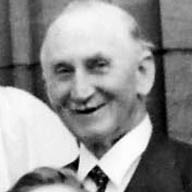
Kenwright, who lived at 76 Robins Lane and was always known as ‘A. J.’, ran a building company which built many of the streets near Sutton Park. During the 1940s and ’50s he became chief warden at All Saints and was a choir member. The unhappy locals were at times joined by a Protestant sect from Liverpool, known as Cromwell's Ironsides, who protested both outside and inside the church during services. They had been founded for the purpose of waging war on 'Roman' practices within the Church of England. The Times reported that the Bishop of Liverpool had expressed sympathy for members of the congregation, who'd been disturbed by 'noisy brawlings or by whispered molestation' when passing to the Holy Table.
The division in the church led to the parochial council organising a rival annual gala to the vicar's. This meant that two sets of processionists walked to Sherdley Park to participate in separate sporting activities. This curious practice continued for a number of years and on June 15th 1935 the Manchester Guardian interviewed both parties about the schism in the church. Kenwright said it was the duty of the Parochial Church Council to organise the gala but the vicar wouldn't co-operate. For his part Rev. Colegrove was quoted as saying that Thompson and Kenwright were "rebelling against the ruling of the parish. I cannot recognise them as allies, when they have appeared as enemies."
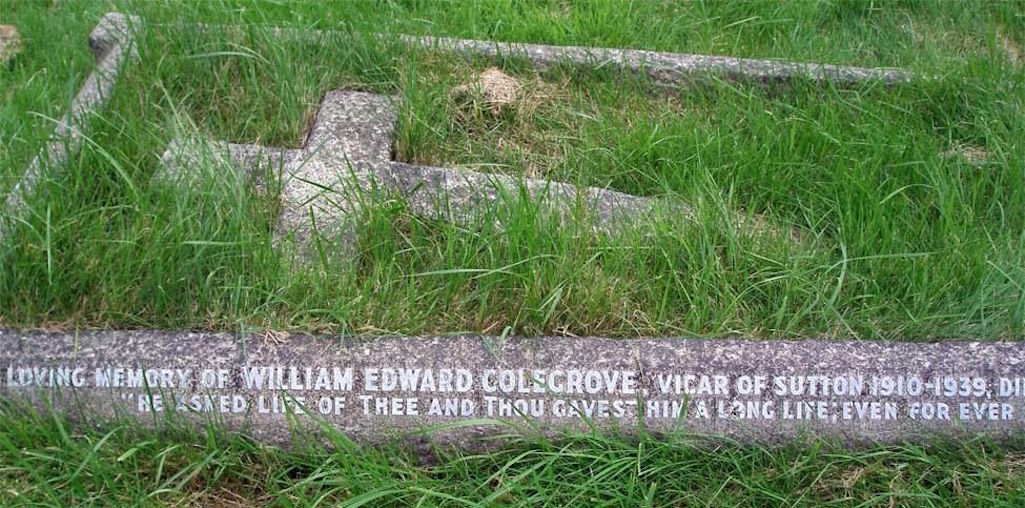
Rev. William Edward Colegrove served Sutton parish for twenty-nine years and has an austere grave at St. Nicholas

Rev. William Edward Colegrove has an austere grave at St. Nicholas

Rev. Colegrove's grave at St.Nicholas
On March 26th Dr. David issued a statement praising Rev. Colegrove's sterling work in his parish and insisting that his controversial service was quite legal. However the Bishop also called for the long-standing and ageing vicar to retire:
The Bishop wrote to Rev. Colegrove directing that the All Saints service should take the form of a full morning prayer with plain Communion. Not receiving a reply, Bishop David sent the Sutton vicar a further letter adding that "I have done my best to help you towards a reasonable solution and I grieve that you have refused my help." The vicar’s flouting of the recommendation led to 40 members of the congregation walking out on Sunday April 19th and 50 members on May 3rd 1936. The controversy over the Choral Eucharist also affected attendances at other services. When the curate Rev. George Garbett (of 126 New Street), conducted an early morning prayer service on the 19th, only one person was present, apart from the organist, one choirboy and two reporters.
In October the malcontents wrote to the bishop to seek permission to hold their own Morning Prayer service. This would have been conducted by laymen but Dr. David would not permit it. On Saturday July 10th 1937, the two rival walking day processions and galas again took place. On the following morning as a concession to the protestors, the vicar conducted a plain morning prayer service but no one turned up. There were, however, fifty members of the congregation at a Choral Eucharist service that immediately followed, although a number walked out when hymn singing began.
Rev. Colegrove told the Daily Mirror that he had been sent a solicitor's letter demanding that the keys, balance sheets, balance in hand, insurance policies and possession of the Blinkhorn parish rooms be given to J. G. Thompson, secretary of the Parochial Church Council and leader of the 'opposition'. The Vicar of Sutton refused, saying "When I am demanded to betray the sacred trust committed to me at my institution, I cannot do it."
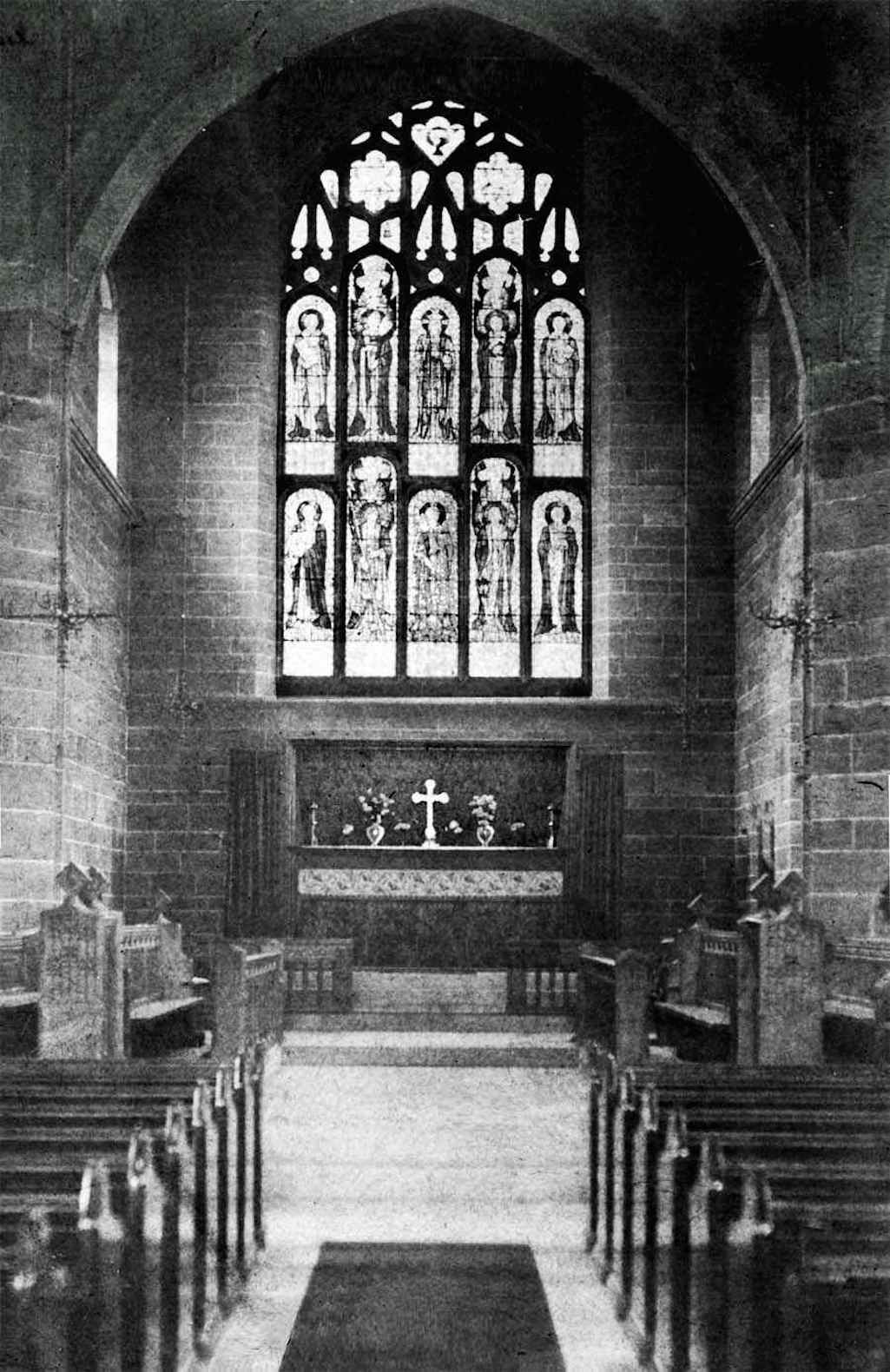
All Saints Church in Ellamsbridge Road c. 1910 which was the subject of much controversy during the 1930s

All Saints Church c.1910, the subject of much controversy during the 1930s

All Saints Church about 1910
In the Daily Mirror's report on the service, they stated that there had also been a sit-down strike: 'Every member sat in silence while the vicar, Rev. W. Colegrove, chanted the service - only the treble voice of an eleven- year-old choirboy, W. Johnson, was heard to make the responses. When the service ended, Mr. Colegrove retired to the vestry. Suddenly the worshippers rose in a body and sang two hymns. They then left the church.'
The All Saints organist, Mr. Wilkinson, then went on strike, refusing to play for the vicar's opponents. He told the Daily Mirror: "They can sing in their own time and (to) their own tune in future, I won't play for them." The dispute was becoming increasingly petty and undignified, exasperating the bishop. First the Parochial Church Council wrote to Mr. Colegrove about a small oak table, presented by his wife, which stood just inside the Ellamsbridge Road church bearing pamphlets. They threatened to make a complaint to the Consistory Court and so the table was withdrawn.
Then on August 31st 1937 the church council unanimously passed a resolution instructing a firm of solicitors to take action against Rev. Colegrove, his wife and Suttoner William Tandy for alleged trespass in the Blinkhorn Parish Rooms. This was after the vicar had attempted to hold his weekly Tuesday evening whist drive in the rooms. The council's vice-chairman A. J. Kenwright said that a recent court ruling had given control of the Waterdale Crescent rooms to the Parochial Church Council. He added that there would only be peace in the parish, once the Anglo-Catholicism introduced by the vicar ceased.
All Saints' services always began with the vicar leaving the vestry followed by a man named Eardley bearing a candelabra. Sutton wags dubbed the assistant 'Owd Colegrove’s disciple'. This long, drawn-out, embarrassing dispute, which was extensively covered by newspapers throughout the land, led to many in the congregation deserting the Ellamsbridge Road church for St. Nicholas.
On February 12th 1939 there was only thirteen worshippers, who sat with their backs to the vicar. The schism in the church was also quite an embarrassment for Dr. David and it must have been a relief for the Bishop of Liverpool when Rev. Colegrove finally resigned. The St.Helens Newspaper of March 10th 1939 cited 'old age' as the reason with the vicar just weeks away from his 80th birthday. The paper also commented that the protests against Choral Eucharist were continuing but had recently taken 'a more orderly form' with several parishioners walking out of the service once a fortnight.

Sutton Parish Church newsletter from 1938 (S.N. = St.Nicholas; A.S. = All Saints) - Contributed by Mel Moran

1938 Sutton Parish Church newsletter (S.N. = St.Nicholas; A.S. = All Saints)

1938 Sutton Parish Church newsletter
Sadly the resignation notice did not calm the dispute. On April 7th 1939 the St.Helens Reporter published a letter from Rev. Colegrove in which the Vicar of Sutton wondered why his opponents of choral Eucharist at All Saints did not instead attend St. Nicholas. This was because the New Street church’s Sunday morning service was always Morning Prayer. The vicar wrote: "Why do they not go there and get what they want? Surely it cannot be because there is a collection at St. Nicholas". Colegrove also denied that Anglo-Catholicism had been introduced at All Saints, adding that the behaviour of men, women and children in the Ellamsbridge Road church on Sundays at 10:15am was a “pitiable sight”. The vicar's final service at All Saints took place on July 9th 1939 and true to form some members and officials of the Parochial Church Council walked out in protest.
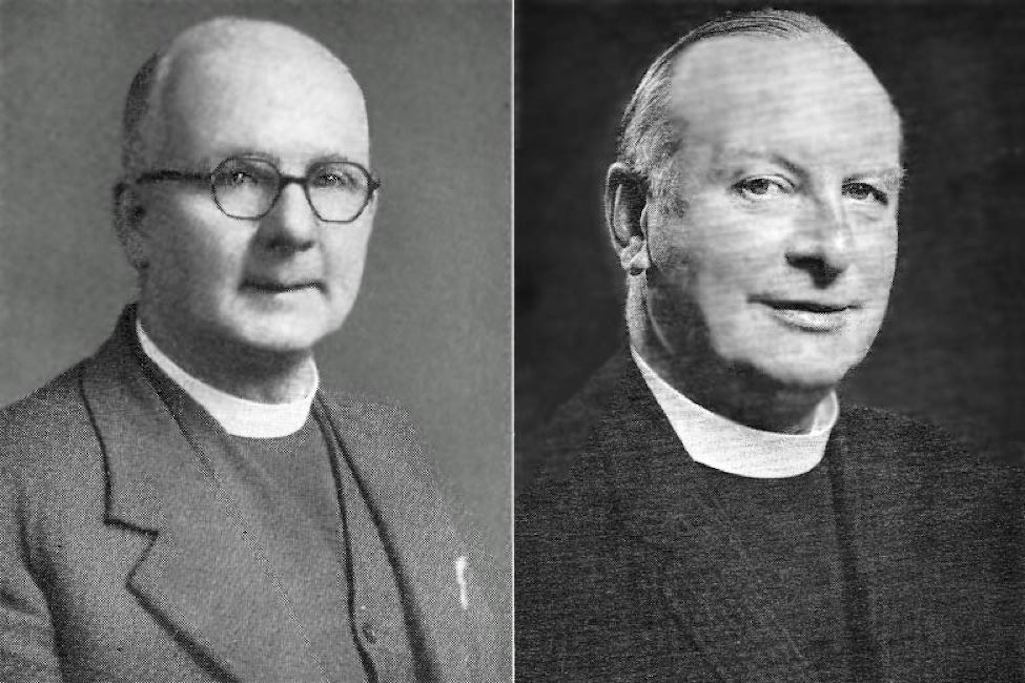
Sutton vicars Rev. J. D. Jones (1939 - 50) and Rev. V. L. Tucker Harvey (1950 - 59) - Contributed by James Prescott

Vicars Rev. J. D. Jones (1939 - 50) & Rev. V. L. Tucker Harvey (1950 - 59)

Vicars Rev. J. D. Jones (1939 - 50) and Rev. V. L. Tucker Harvey (1950 - 59)
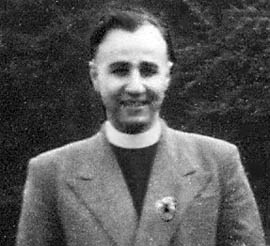
The St. Helens Reporter described the Sutton Parish Church Gala of August 26th 1939 as a ‘striking demonstration of the unity which has returned to that troubled parish. For the first time for a number of years, representatives of every branch of opinion and action in church life joined forces to form a procession which gladdened the hearts and eyes of the onlookers who thronged its route.’
On October 29th 1939 Rev. Jones was instituted Vicar of Sutton by the Bishop of Liverpool. The ceremony took place at All Saints Church, which was described by the St.Helens Reporter as ‘overflowing’. The newspaper wrote that ‘The spirit of the whole Sutton parish was with the Rural Dean (Rev. Arthur Bass), when, during the offering of prayers he said, ‘We beseech Thee, O Lord, that the clergy and people of this parish may be preserved from all scandal, sin and shame; from inconsistency, wavering and fear; that so this church may shine as a light in the world, and be as a city set on a hill.”
The new Vicar of Sutton was then inducted at St. Nicholas Church on the following Sunday by the Archdeacon of Warrington, the Ven. Percy Baker. This public ceremony involved the Archdeacon meeting Rev. Jones at the door of the church and handing him the keys. The vicar then tolled the bell to signify his entrance to his new church and then the Archdeacon escorted him to his stall to continue the service.
Jones served as Vicar of Sutton from the end of 1939 until 1950 and is remembered for his old-style sermons. One of J. D. Jones's biggest achievements was in extending the two church Sunday schools, with as many as 350 children attending the All Saints school alone. He also acquired the Clock Face Colliery Schools for the church, which in 1945 was renamed St. Aidan’s.
A report in the St.Helens Newspaper of June 6th 1941, stated that the organ in St. Nicholas had become unplayable and would cost £28 to repair. The article said that at the next service, Rev. Jones - a gifted musician himself - planned to be in the porch of his church as worshippers entered, in order to receive contributions to an organ fund. However the vicar wasn’t always keen on others playing music.
On October 22nd 1945, amusement caterer H. J. Wallis applied for a music licence for a 10-day fair on land in Herbert Street in Sutton. Rev. Jones said to the magistrates hearing the application: “I object to this mechanical music. It lowers the aesthetic standard.” He did not think it reasonable to “bring fairs practically into people’s houses”. However they ignored his objection and granted the playing of music up to 9.30pm on week nights and to 10.30pm on Saturdays.
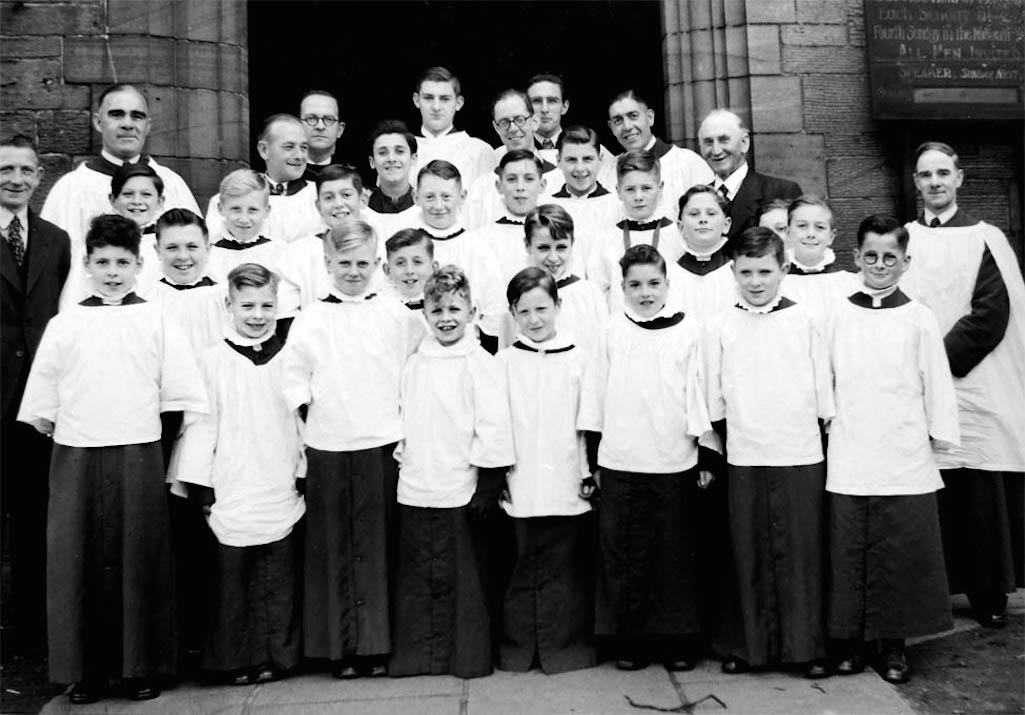
All Saints Church Choir pictured in 1948 - Contributed by Norris Kenwright

All Saints Church Choir pictured in 1948 - Contributed by Norris Kenwright

All Saints Church Choir in 1948
In 1949 electric lighting was installed in St. Nicholas, to replace the gas lighting which had been connected in 1889. Early in 1950 Rev. Jones became the Vicar of Billinge, with V. L. Tucker Harvey becoming his successor in Sutton. In 1955 he formed the 33rd St.Helens Guides at St.Nicholas, which still exists. A tragic incident occurred on May 8th of that year when Canon John William Glendenning collapsed in the pulpit while delivering a sermon and died on the way to hospital. The 75-year-old, who had previously been Vicar of Earlestown and of St. Thomas's Church in St.Helens, had come out of retirement to help out at at St. Nicholas.
A notable curate during the '50s was the Rev. Stanley Winton Kurrle who served Sutton between 1952 and 1954 and resided with Mr. Barton, the long time organist at All Saints. Curates during this time focused on Parish activities at the Ellamsbridge Road church, while the Vicar concentrated on St. Nicholas. Curates did not, however, neglect the New Street church, visiting it on roughly one in every five Sundays.
After returning to his native Australia, Rev. Kurrle become headmaster at two of the country’s prestigious Grammar Schools. From 1955 Rev. Kurrie was in charge of Caulfield Grammar in Victoria and from 1964 until his retirement in 1982, was head at Kings Grammar in Sydney. As of 2014, 92–year-old Rev. Kurrle was living with his wife on sheep property in southern New South Wales but still ministering to the local congregation by holding Bible studies in his home.
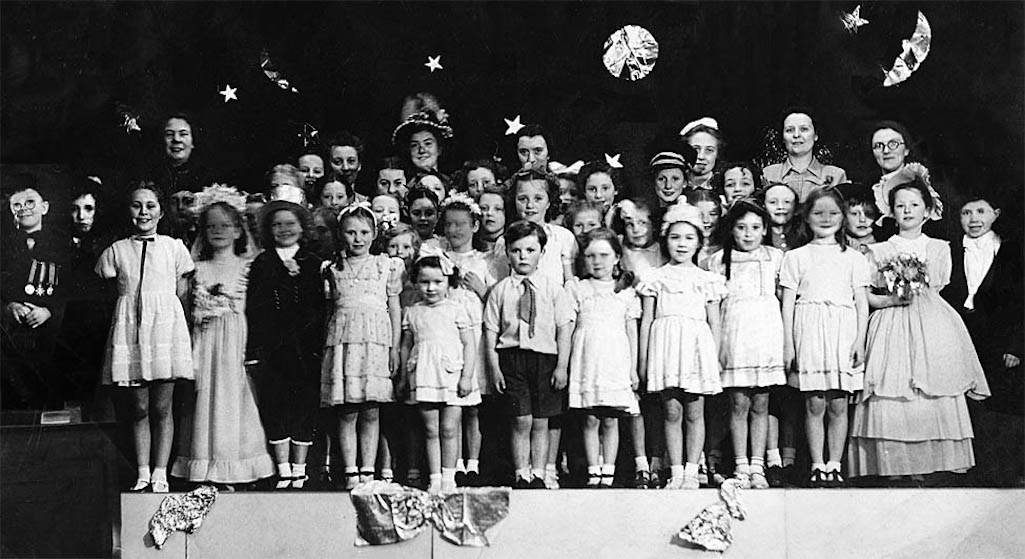
All Saints Sunday School play at Sutton 'Nash' school c.1949 - Contributed by John Barton - View Version With Names

All Saints Sunday School play which was held at Sutton 'Nash' school c.1949 - Contributed by John Barton - View Version With Names

All Saints Sunday School play c.1949
The latter was an extraordinary community endeavour, built over two years by the Vicar and his parishioners' own labour. Reg was another Sutton vicar to make it into The Times after he'd persuaded a soap manufacturer to make 'Sutton Parish Hall' branded soap bars. Rev. Smith then recruited a salesforce of female church workers to sell his soap door to door in Sutton, with the proceeds going towards the £25,000 estimated cost of materials for the new hall.
Sutton's first vicar, Henry Vallancey, probably turned in his modest grave at the front of St Nicholas! When he needed funds, Vallancey sent out letters to his wealthy parishioners and as local representative of the all-powerful church, they didn't dare refuse him. However, in the era of the swinging sixties and diminishing church attendances, vicars had to develop lateral thinking when fundraising. However, Rev. Smith's soap initiative, which bypassed local traders, went down badly with one of them. Charles Lee, the owner of a hardware shop, was not impressed by the competition and was quoted in The Times on January 7th 1963:
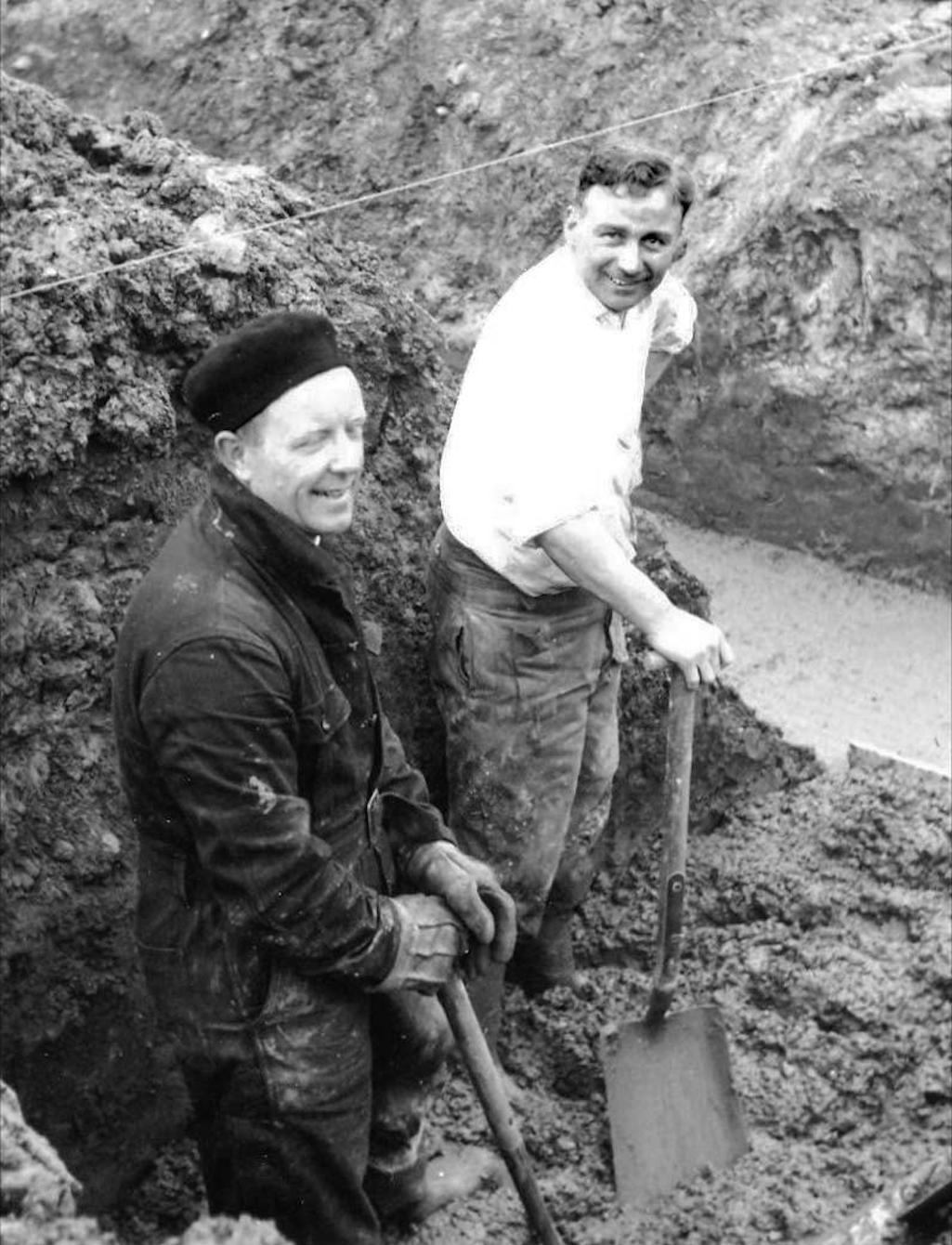
Rev. 'Reg' Smith (left) in March 1963 doing the spadework for the St.Nicholas Parish Hall (contributed by James Lamb)

Rev. Smith (left) in March 1963 doing the spadework for the Parish Hall

Rev. Smith (left) in March 1963 doing the spadework for Sutton Parish Hall
Other remembered curates of the 1960s were C. M. A. Dawson, Dennis Rider, Bill Harrington, Fred Cheal, Derek Bailey, Brian Robinson, John Lewis, Raymond Edgell and Jeremy Howett. Rev. Harrington took over J. Waine's role at All Saints when he left in 1960 and then in May 1964 he replaced him at St. Michael's at Ditton. John Lewis became Archdeacon of Europe. In later years H. R. L. Bonsey had responsibility for the Ellamsbridge Road church, living at the vicarage at 30 Waterdale Crescent.
In September 1966 Reg Smith left Sutton to become Rural Dean of the Parish of Bury and was awarded an MBE in 1997, six months before his death. His successor was Paul Collingwood Nelson Conder who was the eighth (and final) Vicar of Sutton and who took up his office in July 1967. The St Helens Reporter on March 9th 1968 described how the Rev. and Mrs. Conder had travelled to Aberdeen to launch a trawler, with Mrs. Conder crashing the traditional bottle against the boat’s bows. The 86 feet-long vessel called Spinningdale was part-owned by her father, hence the invite to launch it.
During the evening of July 18th 1968, seventy-five Sutton parishioners visited Liverpool Anglican Cathedral and handed over £50 towards the ‘Finish the Cathedral Appeal’. The money came from collections at St Nicholas, All Saints and St Michael’s churches.
On August 3rd 1968 the St Helens Reporter described how Rev. Derek Bailey had had his bike stolen. The curate had parked his machine for just twenty minutes in an alley outside St Helens Hospital’s main entrance while he visited parishioners. As well as losing his bike, Rev. Bailey - who’d joined the Sutton parish in September 1967 - lost an important diary, which contained appointments and contact details. A fortnight later during morning service at All Saints, Rev. Raymond Edgell presented his annual book prize to Leslie Guest. The nine-year-old from Hoghton Road was rewarded for being the best-behaved choirboy who had made the best progress during the year.
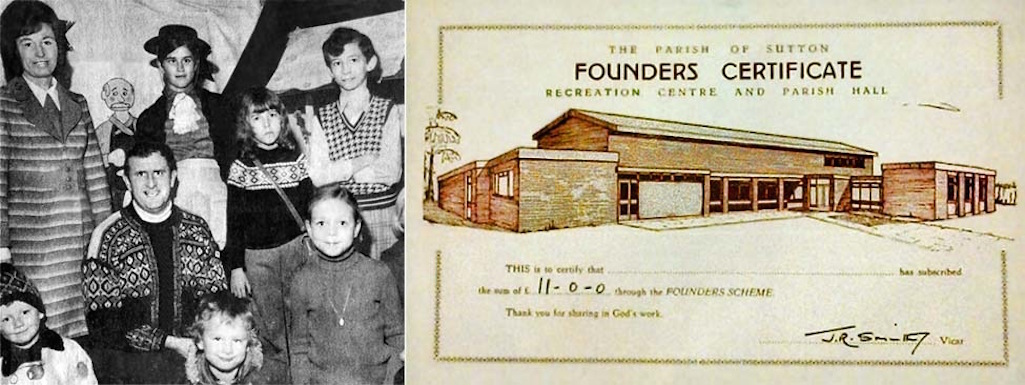
Rev. Paul Conder & wife Lesley at St.Nicholas Winter Fayre and Parish Hall Donor Certificate - contributed by Jim Lamb

Rev. Paul Conder at St.Nicholas Winter Fayre & Parish Hall Donor Certificate

Rev. Paul Conder and wife Lesley plus a Parish Hall Donor Certificate
On August 23rd 1968 in Sutton Parish Hall more than 200 parishioners attended a farewell party for two curates who were leaving for pastures new. Rev. Raymond Edgell was going to become the Vicar of St Paul’s in Bury and Rev. J. S. Bailey was leaving to work in the parish of St Paul in Warrington. The 52-year-old Rev. Edgell had spent most of his working life in St.Helens Police, where he became a sergeant. In 1963 he decided to leave the force and enter the ministry and had since spent three years as curate-in-charge of All Saints Church. At St. Paul’s in Bury he would be reunited with the Rev. ‘Reg’ Smith, who (as previously stated) was now the Rural Dean.
Both curates had been in Sutton for three years and received gifts from the parishioners. A wristwatch was also presented to John Barr of Yew Tree Avenue, who had served as parish clerk and verger for 25 years. On October 1st 1968 Rev. Brian Robinson joined Sutton Parish as curate-in-charge of All Saints, until he was appointed Vicar of St. Hilda's at Hunts Cross in January 1972.
It was the Sutton Parish Church Winter Fair on November 22nd and 23rd 1968 and thousands crowded into the Parish Hall on New Street. The St Helens Reporter said: “The attractive and well-laden stalls were the result of a year’s hard work by the social committee, who had knitted, sewed, bottled fruit and jam and such, and organised various fund-raising efforts.”
The church youth club had transformed the hall stage into a “wonderland” with Father Christmas in his grotto. The fair provided the bulk of the £1,000 fundraising target that Sutton Parish had set for 1968, with the proceeds going to funds connected with the parish’s churches and schools. On December 19th 1968 the choir of St. Anne’s RC Church joined Sutton Parish Church’s choir for a combined carol service. This was the fourth year in succession that this event had been held and it took place in St. Anne’s School Hall in Monastery Road. Prayers were said by the Rev. Paul Conder and the Rector Father Christopher.
In April 1969 the Vicar of Sutton announced this week that for a three-month trial period Sunday school classes at St Nicholas and All Saints would be held in the morning instead of the afternoon. Rev. Paul Conder said that children would attend morning service along with their parents but after fifteen minutes the St Nicholas kids would leave to attend classes in the parish hall. Those youngsters that were attending at All Saints church, would leave for Sunday school classes at the Sutton National junior school.
On May 3rd 1969 a Spring Fair was held in the junior school in Ellamsbridge Road, which raised £206 (around £3,000 in today’s money) in aid of Sutton Parish’s new school building fund. In July 1969 it was announced that Rev. Derek Bailey – the curate-in-charge of St. Michael’s – would be leaving the parish in September for a similar position in Derbyshire. His replacement would be the Rev. Eric Rotherham, at present a curate at Great Crosby. Before his ordination Mr Rotherham qualified as a chartered secretary and worked in the transport and accounts department of a national firm.
The invitation that children received to Sutton Parish Church's Holiday Club ‘69 said: "Come and make a boat, build an ark, be ship-wrecked or swallowed by a whale". It was a week-long series of morning activities at the parish hall in New Street during August 1969 that attracted 100 children to each session aged between six and ten. The boys and girls could paint, play games, make models and participate in plays. The materials used included egg cartons, cereal packets, washing-up liquid, containers, newspapers, clay and 26lb of paint.
Rev. Derek Bailey told the St Helens Reporter: "There was very little noise or mess. We hope the club was a means of getting into contact with children who have previously not been connected with us. Also, we hope it increases the children’s understanding of the Christian faith. The plays they enacted were a means of putting the message across. That was really the idea. It was not just a child-minding service." The parents were invited to an open evening in the parish hall to view the models and work done by their children.
On September 19th 1969 the St Helens Reporter wrote that a team from All Saints Church in Sutton planned to visit every house in the area during the following week with an invitation to attend the harvest services. On September 23rd a public meeting to discuss the future of church schools in Sutton was held in the Parish Hall. In his parish magazine Rev. Conder wrote that some “critical decisions” concerning the future of the schools would have to be taken very soon and he wanted the issues involved to be explained to all who were interested. Of particular concern was the high Bank Rate that was increasing the cost of loan charges. The Vicar of Sutton had only recently returned from a preaching tour of the United States and wrote an article on his experiences in the St.Helens Reporter.
'The Parson Calls' is said to have been a national institution on the Home Service from 1949 to 1952 in which Wilfrid Garlick delivered a weekly radio sermon in a down-to-earth Lancashire style. On September 28th Canon Garlick was one of the two guest preachers in the harvest services at St Nicholas Church in Sutton. The Rev. Harry Bellis, the recently retired Vicar of Rainford, was the other preacher.
In early November of 1969, Rev. Conder appealed for individuals to volunteer as Sunday school teachers. The building of more housing estates was leading to an increase in the number of children that were attending the three schools at St. Nicholas, All Saints and St. Michael’s. A Sutton Parish carol and coffee evening was held on the December 17th 1969 at an unusual venue. The event was held at 126 New Street, as that was the home of the Rev. Brian Robinson, the curate-in-charge of All Saints. The proceeds went to the school building fund.
In the Sutton Parish Magazine for March 1970 Rev. Paul Conder announced that the restoration of St. Nicholas Church would begin after Easter and continue throughout the summer. The church had been badly damaged by subsidence and the National Coal Board had agreed to undertake the repairs. Once they had finished painters would move in. It had also been decided to rewire the church, provide new lighting and install a new choir vestry. This would cost over £2,000 and the church was trying to raise the cash and the vicar appealed for donations.
In his church magazine for May, the Rev. Conder wrote that he was considering setting up a body of vigilantes to stop an outbreak of vandalism. The Sutton vicar complained of windows being smashed at St. Nicholas and All Saints churches, with the windows in the vestry and porch of the former being regular targets. Paul Conder appealed for help from parents and felt that a "band of watchers" would be a good idea and would discussed at a church meeting.
The St Helens Reporter on August 21st 1970 reported that vandals had smashed a window at St. Nicholas Church – only a fortnight after experts had restored it. The stained glass window was valued at £600 – about £10,000 in today's money – and as part of the church renovation scheme to address subsidence, the glass had been removed in sections, cleaned and replaced. Church Warden Fred Thomas of New Street told the Reporter:
In December 1974 the Bishop of Liverpool decided to restructure the parish. The four clergyman who served the three Sutton churches now became members of a team ministry, led by a Rector. Rev. Conder adopted that role until November 1975, when he became Vicar of Thames Ditton. His successors were Michael Soulsby (1976 - 89), and John L. Higham, who held the position of Rector. Consequently the Sutton Vicarage in New Street, opposite the cricket club, became known as Sutton Rectory. Since 1990 with the appointment of Stephen Mather, who served the parish for six years, Sutton Parish has been served by Team Vicars.
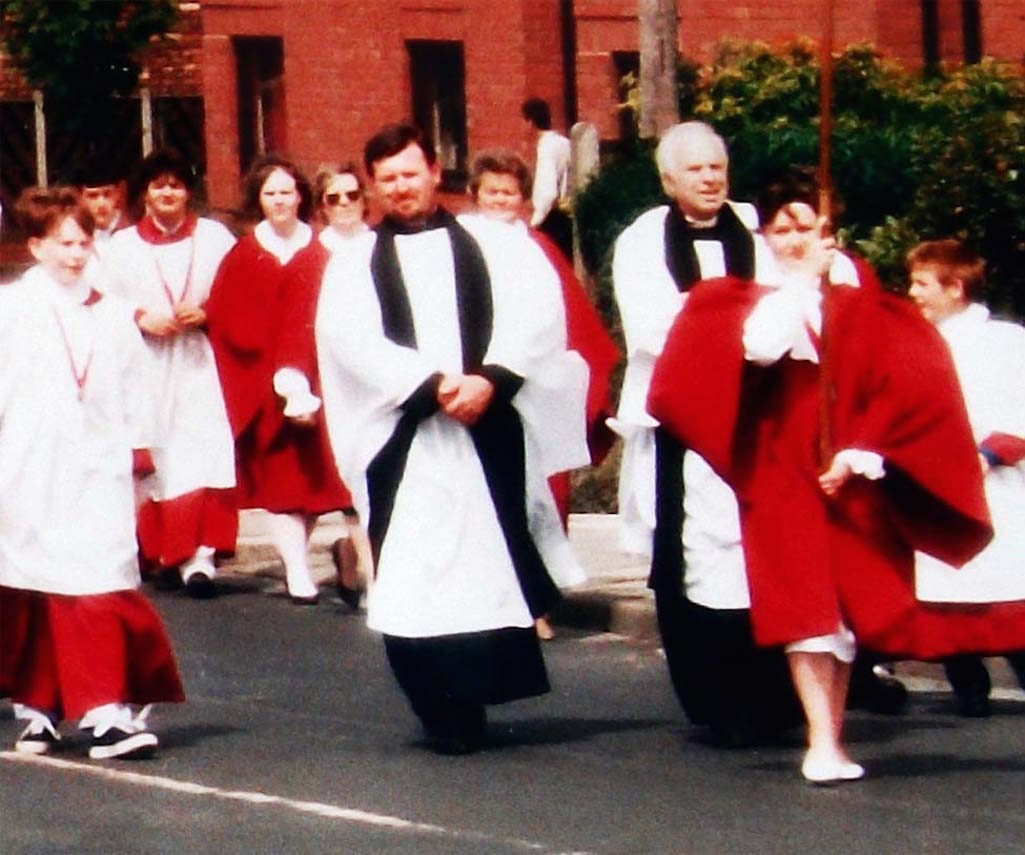
Revd. S. A. Mather (left) and Rev. M. Soulsby (right) at St.Nicholas Gala day c.1990 - contributed by James Lamb

Revds. Mather (left) and Soulsby (right) at St.Nicholas Gala day c.1990

Revds. Mather (left) and Soulsby (right) at St.Nicholas Gala day c.1990
The successful applicant would have responsibility for three churches, serving a population of 27,000 from a new, modest rectory. These days there is much more organisation required to preach the gospel and provide pastoral care for the Sutton community and so a team ethos thrives.
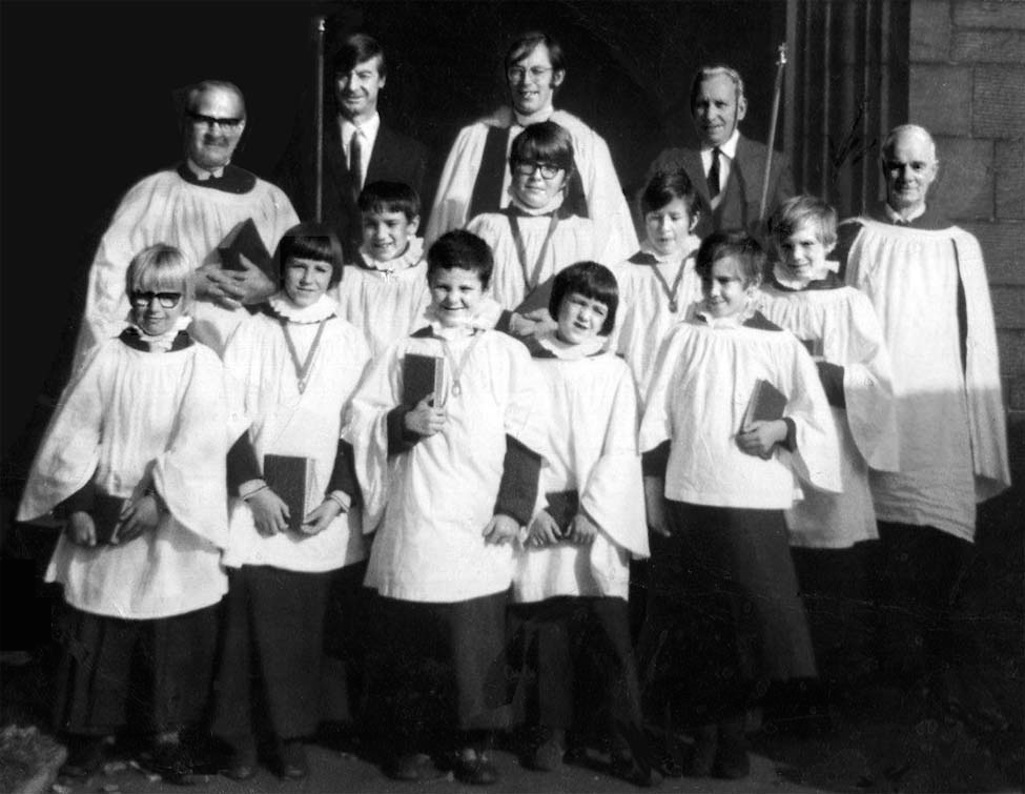
All Saints Church Choir pictured about 1973 - Organist Bill Barton is extreme right - Contributed by Julie Bligh

All Saints Church Choir about 1973 - Organist Bill Barton is extreme right

All Saints Church Choir about 1973
On September 15th 1990, Ven. G. Spiers, Archdeacon of Liverpool, inaugurated the building of an extension of St. Nicholas that would create a St. Cecilia Vestry Chapel (the patron saint of music), a refurbished kitchen, vicar’s vestry and toilets. The church had experienced much controversy at various times during the 20th century. One wouldn't have thought that a relatively small-scale building extension would add to it, but it did!
St Nicholas became in dispute with St.Helens Council over the design and type of materials that were to be used, a disagreement that lasted several years. As the building is Grade II listed, the authority insisted on the extension being in sandstone to match the character of the rest of the church. However this meant that the total bill for the work would be a whopping £133,000.
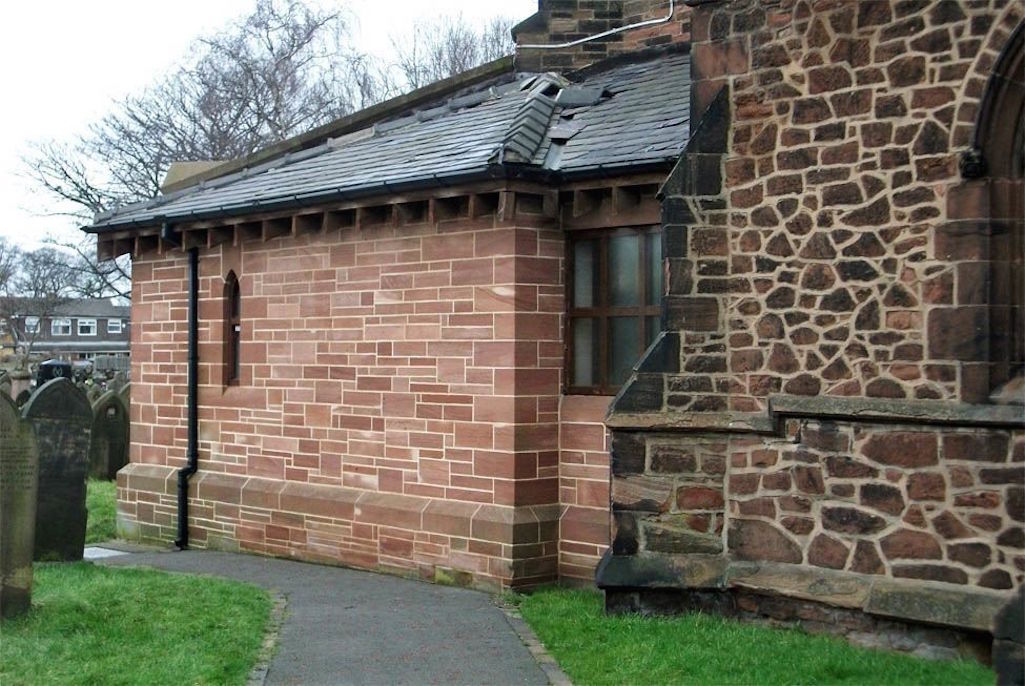
Part of the extension to St Nicholas Church which caused an issue with St.Helens Council for five years

Part of the St Nicholas extension which caused an issue with the Council

Part of the St Nicholas extension
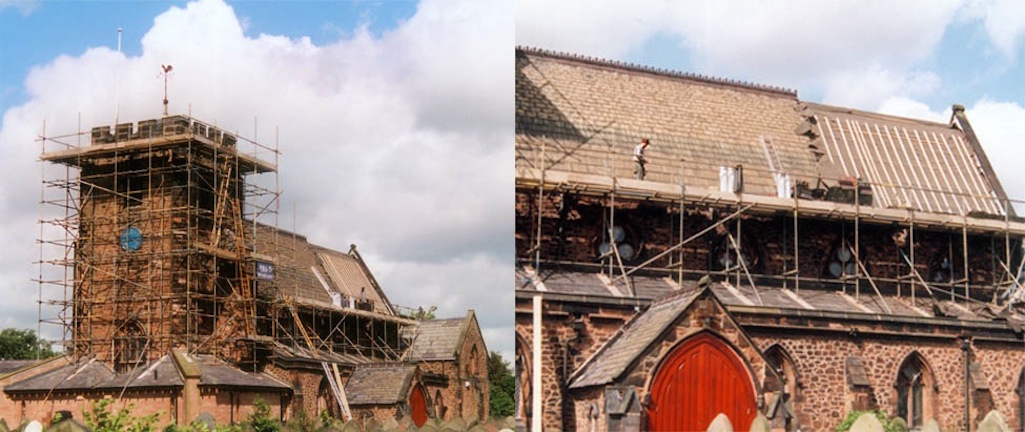
Repairs to the St Nicholas Church roof which took place during June 1994 - photographed and contributed by James Lamb

Repairs to the St Nicholas Church roof which took place during June 1994

Repairs to St Nicholas roof in June 1994
